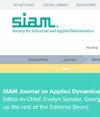Reduction of Chemical Reaction Networks with Approximate Conservation Laws
IF 1.8
4区 数学
Q2 MATHEMATICS, APPLIED
引用次数: 0
Abstract
SIAM Journal on Applied Dynamical Systems, Volume 23, Issue 1, Page 256-296, March 2024.Abstract. Model reduction of fast-slow chemical reaction networks based on the quasi-steady state approximation fails when the fast subsystem has first integrals. We call these first integrals approximate conservation laws. In order to define fast subsystems and identify approximate conservation laws, we use ideas from tropical geometry. We prove that any approximate conservation law evolves more slowly than all the species involved in it and therefore represents a supplementary slow variable in an extended system. By elimination of some variables of the extended system, we obtain networks without approximate conservation laws, which can be reduced by standard singular perturbation methods. The field of applications of approximate conservation laws covers the quasi-equilibrium approximation, which is well known in biochemistry. We discuss reductions of slow-fast as well as multiple timescale systems. Networks with multiple timescales have hierarchical relaxation. At a given timescale, our multiple timescale reduction method defines three subsystems composed of (i) slaved fast variables satisfying algebraic equations, (ii) slow driving variables satisfying reduced ordinary differential equations, and (iii) quenched much slower variables that are constant. The algebraic equations satisfied by fast variables define chains of nested normally hyperbolic invariant manifolds. In such chains, faster manifolds are of higher dimension and contain the slower manifolds. Our reduction methods are introduced algorithmically for networks with monomial reaction rates and linear, monomial, or polynomial approximate conservation laws. We propose symbolic algorithms to reshape and rescale the networks such that geometric singular perturbation theory can be applied to them, test the applicability of the theory, and finally reduce the networks. As a proof of concept, we apply this method to a model of the TGF-beta signaling pathway.
用近似守恒定律还原化学反应网络
SIAM 应用动力系统期刊》第 23 卷第 1 期第 256-296 页,2024 年 3 月。 摘要。当快速子系统具有初积分时,基于准稳态近似的快慢化学反应网络模型还原就会失败。我们称这些初积分为近似守恒定律。为了定义快速子系统并确定近似守恒定律,我们使用了热带几何的思想。我们证明,任何近似守恒定律的演化速度都比其涉及的所有变量慢,因此代表了扩展系统中的一个补充慢变量。通过消除扩展系统中的某些变量,我们可以得到没有近似守恒定律的网络,这些网络可以通过标准奇异扰动方法进行还原。近似守恒定律的应用领域包括准平衡近似,这在生物化学中是众所周知的。我们讨论了慢-快以及多时间尺度系统的还原。具有多个时间尺度的网络具有层次松弛。在给定的时间尺度下,我们的多时间尺度还原方法定义了三个子系统,分别由(i) 满足代数方程的从动快速变量,(ii) 满足还原常微分方程的慢速驱动变量,以及(iii) 恒定的淬火慢速变量组成。快速变量满足的代数方程定义了嵌套的常双曲不变流形链。在这些流形链中,速度较快的流形维度较高,包含速度较慢的流形。我们通过算法介绍了针对具有单次反应速率和线性、单次或多项式近似守恒定律的网络的还原方法。我们提出了重塑和调整网络规模的符号算法,以便将几何奇异扰动理论应用于网络,测试理论的适用性,并最终还原网络。作为概念验证,我们将此方法应用于 TGF-beta 信号通路模型。
本文章由计算机程序翻译,如有差异,请以英文原文为准。
求助全文
约1分钟内获得全文
求助全文
来源期刊

SIAM Journal on Applied Dynamical Systems
物理-物理:数学物理
CiteScore
3.60
自引率
4.80%
发文量
74
审稿时长
6 months
期刊介绍:
SIAM Journal on Applied Dynamical Systems (SIADS) publishes research articles on the mathematical analysis and modeling of dynamical systems and its application to the physical, engineering, life, and social sciences. SIADS is published in electronic format only.
 求助内容:
求助内容: 应助结果提醒方式:
应助结果提醒方式:


